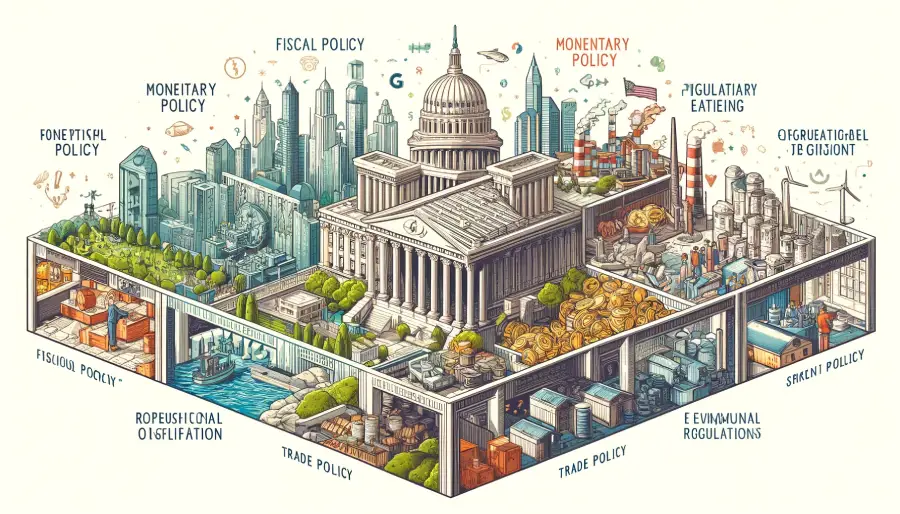Economic policies are fundamental tools used by governments to influence a nation’s economic activity. These policies can be broadly categorized into fiscal policy, monetary policy, trade policy, and regulatory policy. Analyzing economic policies involves examining their objectives, mechanisms, and outcomes to understand their impact on economic growth, stability, and distribution of wealth. This article provides a comprehensive analysis of various economic policies, their theoretical underpinnings, and real-world applications.
Fiscal Policy
Definition and Objectives: Fiscal policy involves government spending and taxation decisions aimed at influencing economic activity. The primary objectives are to promote economic growth, reduce unemployment, and control inflation.
Mechanisms:
- Government Spending: Increased public expenditure on infrastructure, education, and healthcare can stimulate economic activity by creating jobs and enhancing productivity.
- Taxation: Adjusting tax rates and structures can influence consumer spending and investment. Lower taxes increase disposable income, leading to higher consumption and economic growth.
Case Study: During the 2008 financial crisis, many governments implemented stimulus packages that included increased public spending and tax cuts to revive economic activity. These measures helped mitigate the recession’s impact and supported economic recovery.
Monetary Policy
Definition and Objectives: Monetary policy is conducted by a nation’s central bank to control money supply and interest rates. Its main objectives are to maintain price stability, control inflation, and achieve low unemployment.
Mechanisms:
- Interest Rates: Central banks adjust interest rates to influence borrowing and spending. Lower interest rates make borrowing cheaper, encouraging investment and consumption.
- Quantitative Easing: Involves the purchase of government securities to increase money supply and lower interest rates, stimulating economic activity.
Case Study: In response to the COVID-19 pandemic, central banks worldwide reduced interest rates and implemented quantitative easing to support economies and maintain liquidity in financial markets.
Trade Policy
Definition and Objectives: Trade policy encompasses tariffs, trade agreements, and regulations that govern international trade. The objectives are to protect domestic industries, promote exports, and manage trade deficits.
Mechanisms:
- Tariffs and Quotas: Imposing tariffs and quotas on imports can protect domestic industries from foreign competition.
- Trade Agreements: Bilateral and multilateral trade agreements can reduce trade barriers and enhance market access for domestic producers.
Case Study: The North American Free Trade Agreement (NAFTA), now replaced by the United States-Mexico-Canada Agreement (USMCA), aimed to eliminate trade barriers between the U.S., Canada, and Mexico, boosting trade and economic integration.
Regulatory Policy
Definition and Objectives: Regulatory policy involves rules and regulations governing business practices, labor markets, and environmental standards. The goals are to ensure fair competition, protect consumers and workers, and promote sustainable development.
Mechanisms:
- Antitrust Laws: Prevent monopolies and promote competition to enhance market efficiency.
- Labor Regulations: Ensure fair wages, working conditions, and workers’ rights.
- Environmental Regulations: Limit pollution and encourage sustainable practices.
Case Study: The Clean Air Act in the United States sets standards to reduce air pollution, protecting public health and the environment. It has led to significant improvements in air quality and public health outcomes.
Policy Evaluation and Impact Analysis
Evaluating Effectiveness: The effectiveness of economic policies is evaluated based on their ability to achieve intended objectives, such as economic growth, employment, and price stability. Key performance indicators include GDP growth rate, unemployment rate, inflation rate, and trade balance.
Unintended Consequences: Policies may have unintended side effects, such as increased debt from fiscal stimulus or asset bubbles from prolonged low interest rates. Policymakers must consider these potential impacts and adjust strategies accordingly.
Distributional Effects: Economic policies can have varying effects on different population groups. For instance, tax cuts may disproportionately benefit higher-income individuals, while public spending on social programs can support low-income households. Analyzing these distributional effects is crucial for designing equitable policies.
Conclusion
Economic policies play a critical role in shaping the economic landscape of a nation. Through fiscal, monetary, trade, and regulatory policies, governments can influence economic activity, promote growth, and ensure stability. A thorough analysis of these policies, considering both intended and unintended effects, is essential for informed decision-making and effective governance. By understanding the impact and implications of economic policies, policymakers can design strategies that foster sustainable and inclusive economic development.

